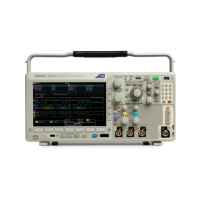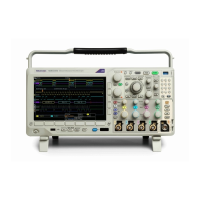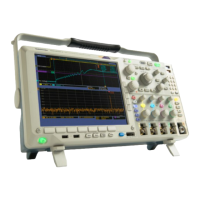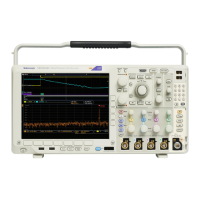Save and Recall I
nformation
5. Push File Details to save to a USB or
network drive.
File Details
This brings up the file manager screen. Use
it to navigate to the desired drive and folder,
and optional
ly to specify the file name.
Skip this step to use the default name and
location.
Saving a wav
eform to file.
When you push File Details on the side menu, the oscilloscope changes the side menu contents.
The following table describes these side menu items for saving data to a mass storage file.
Side m e nu button
Description
Instrument SpecificFile
Format (.I
SF)
Sets the oscilloscope to save data from analog, digital, or RF channels (and math and
reference
waveforms derived, where possible, from those channels), in Instrument Specific
Format (.isf) format. This format is the fastest to write. It also creates the smallest-sized file.
Use this format if you intend to recall an analog waveform or RF trace to reference memory
for viewi
ng or measuring.
Spreads
heet file format
(.csv)
Sets the
oscilloscope to save data as a comma-separated data file that is compatible with
popular spreadsheet programs.
Analog and RF data stored in this file format can also be recalled to reference memory.
Saving a waveform or trace to reference memory. To save a waveform or trace to nonvolatile memory inside the
oscilloscope, push the Save Waveform screen button, select the waveform that you want to save, and then select one of
the reference w aveform locations.
Saved waveforms contain only the most recent acquisition. Gray-scale information, if any, is not saved.
NOTE. 10 M reference waveforms are volatile and not saved when the oscilloscope power is turned off. To keep these
waveforms, save them to external storage.
Displaying a reference waveform. To display a waveform stored in nonvolatile memory:
1. Push Ref R.
MDO3000 Series Oscilloscopes User Manual 167

